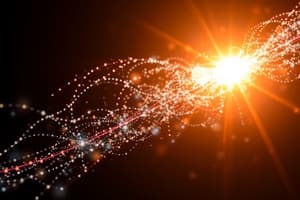Podcast
Questions and Answers
What is the phenomenon called when light waves behave like particles and waves?
What is the phenomenon called when light waves behave like particles and waves?
wave-particle nature of light or wave-particle duality
What is the evidence for the wave-particle nature of light?
What is the evidence for the wave-particle nature of light?
photoelectric effect, diffraction and interference of light in Young's Double Slit experiment
What is the photon model of light?
What is the photon model of light?
Electromagnetic waves carrying energy in discrete packets
What is the interaction of light with matter called?
What is the interaction of light with matter called?
What is the diffraction and interference of light in Young's Double Slit experiment evidence for?
What is the diffraction and interference of light in Young's Double Slit experiment evidence for?
What is the definition of electric current?
What is the definition of electric current?
What are the units of measurement for electric current?
What are the units of measurement for electric current?
What is the symbol used to represent current?
What is the symbol used to represent current?
What is the equation that relates charge, current, and time?
What is the equation that relates charge, current, and time?
What happens when two oppositely charged conductors are connected together?
What happens when two oppositely charged conductors are connected together?
What is the equation that relates charge, current, and time?
What is the equation that relates charge, current, and time?
What are the units of measurement for electric current?
What are the units of measurement for electric current?
What is the symbol used to represent current?
What is the symbol used to represent current?
What is the definition of electric current?
What is the definition of electric current?
What happens when two oppositely charged conductors are connected together?
What happens when two oppositely charged conductors are connected together?
Flashcards are hidden until you start studying
Study Notes
Wave-Particle Duality of Light
- Light exhibits wave-particle duality, meaning it can behave as both waves and particles.
- The wave-particle nature of light is evident in its ability to exhibit diffraction and interference patterns, as well as displaying particle-like behavior.
Photon Model of Light
- The photon model of light describes light as composed of particles called photons.
- Photons have both wave-like and particle-like properties.
Interaction of Light with Matter
- The interaction of light with matter is called electromagnetic radiation.
Young's Double Slit Experiment
- The diffraction and interference of light in Young's Double Slit experiment demonstrate the wave-like nature of light.
- The experiment shows that light passing through two slits creates an interference pattern on a screen.
Electric Current
- Electric current is the flow of electrons through a conductor.
- The units of measurement for electric current are amperes (A).
- The symbol used to represent current is I.
- The equation that relates charge, current, and time is I = Q / t, where I is current, Q is charge, and t is time.
- When two oppositely charged conductors are connected together, the electrons flow from the negatively charged conductor to the positively charged conductor, resulting in the neutralization of the charges.
Studying That Suits You
Use AI to generate personalized quizzes and flashcards to suit your learning preferences.




